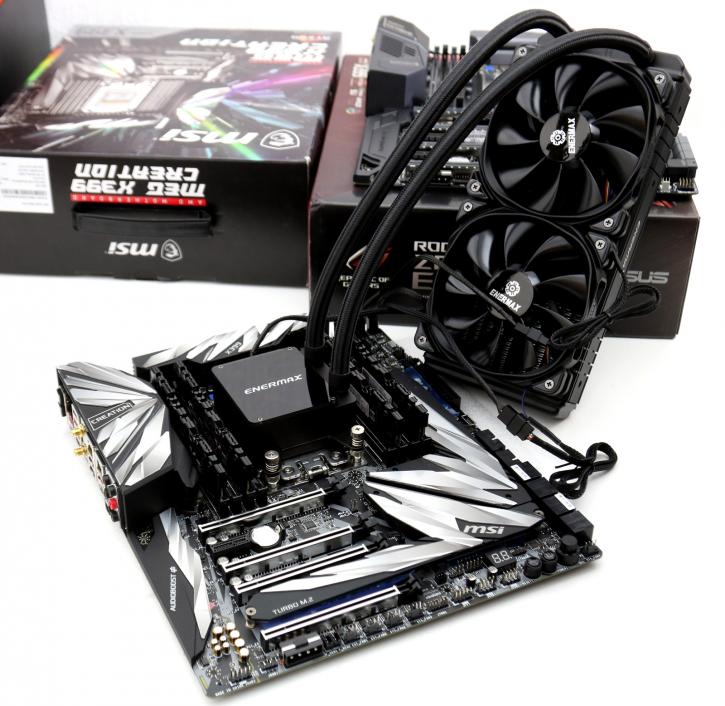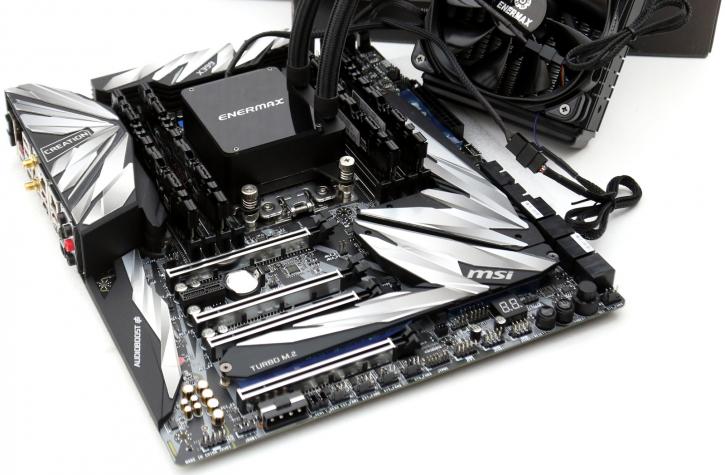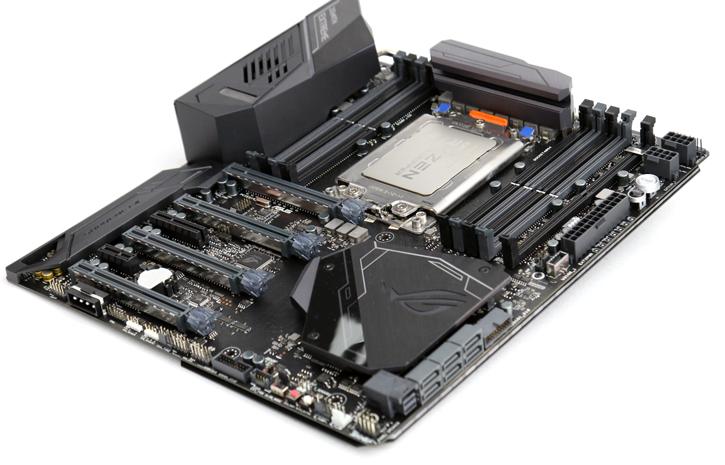The Clevertron - HEDT at home
The Clevertron - HEDT at home
With AMD being, let's face it, in CPU no-man's land for many years, Intel's take on the high-end desktop market was usually prohibitively expensive. This reached a peak with the Broadwell-E based i7 6950X, which cost a simply eye-watering $1750. 10 cores and 20 threads, however, was needed by some, so people bought it. Then, however, we got Ryzen.
Ryzen really was, for all of its initial faults, a game changer. Suddenly, the cost of an 8 core/16 thread processor had fallen from $1000-1100 USD, to just $330 (in the case of the R7 1700). The cost of a motherboard for this processor? As little as $75, for a decent one. With one move, AMD had blown the HEDT market wide open. Sure, the deca-core CPU was still unattainable for most, but that was about to change, as well.
Without wishing to elongate this article any further, the situation in 2018 is this:
- For certain use cases, the Threadripper 2990WX is the king of workstation grade CPUs. 32 cores, 64 threads, all for sub $2,000 USD.
- Intel and AMD compete with each other on the X299 and X399 platforms, respective. Skylake-X on the former, and Threadripper (2) on the latter.
- These platforms bridge the gap between the regular desktop market, and the enterprise/server one.
- They are the choice for those who need more than the 8 cores/16 threads of the R7 2700X, or the upcoming i9 9900k.
So, if you wish to get into this market, then what do you need to do? Well, first up, ensure that what you seek to do will actually benefit from such a high number of CPU cores, and that you are not hitting a point of rapidly diminishing returns. Remember, just because you have all of that CPU horsepower at your disposal doesn't mean that whatever application you happen to use can take advantage of them. A famous example is Adobe Premiere Pro, which saw very poor scaling beyond hexacore CPUs up until late 2017. The link to our CPU review page is here. Bear in mind that the highest end Skylake-X CPU that we have looked at is the 10 core/20 thread 7900X, whereas we have looked at all current Threadripper 2 CPUs up to the 32 core 2990WX. Some applications scale excellently with cores, and others prefer a combination of cores and single core clock rate. Use your better judgment, therefore, to decide if AMD's higher core count wins your vote, or Intel's slightly superior IPC and notably better clock rate is worth your hard earned dollars. There is, for the record, no right or wrong choice, only the choice that will benefit you the most.
Right, we got there. If you do still want to get into this market, then please read on for some very general guidelines.
Processor choice - AMD
Until Intel's next-generation Cascade Lake drops, AMD has a highly convincing lead in the core count war, hands down. This article will focus on Intel's current Skylake-X platform, vs. AMD's Threadripper 2 lineup. The latter is about to expand further, adding 12 and 24 core 'WX' designated (i.e. Workstation orientated) CPUs to the lineup. The 12 core is a replacement for the excellent value 1920X of yesteryear, and the 24 core part is, potentially, a nice little stopgap between the 2950X and 2990WX.
For now, however, let's focus on the 2950X and 7980XE. The price differential between these two CPUs is, quite simply, staggering. The 2950X can, right now, be had off Newegg.com for just over 850 USD. The Intel chip, which carries two more cores, commands a near 1,000 USD premium. Remember, this is not 'old' Threadripper. This is Pinnacle Ridge based 12nm Threadripper. Coming in at a 180W TDP, the 2950W contains 16 cores, 32 threads, and has support for 64 PCIe lanes, as well as quad channel memory. It can turbo to 4.4Ghz on four cores, and can comfortably sit at 3.8-3.9GHz on all cores when heavily loaded. Naturally, one can overclock the whole chip, but you will see a fairly major spike in power consumption. For some, that'll be worth it. For others, not so much.
If you have software that can truly take advantage of 16 cores/32 threads, then the 2950X is an excellent CPU. Naturally, when compared to its higher clocked Intel counterparts, it will suffer in gaming as well as programs that still prefer higher clock rates or single core performance. However, if you are buying into X299 or X399 for gaming, you're doing something wrong. Go away, and come back with an 8700k or 2700X (at most), and you'll save a tonne of money for better performance.
Realistically speaking, the 2990WX is a relevant product for only a few people. Windows still has trouble really taking advantage of such a high thread count (a fact which became painfully obvious where re-testing of said CPU was done in Linux based operating systems, where performance was... well, dramatically different), making it a very niche product. By comparison, for 850USD, the 2950X is a godsend to those wanting high end and high core count computing from the comfort of their own home. Just because the 2950X comes in at below 1000 USD certainly doesn't mean a PC based around it will be cheap, but I was able to select a CPU, motherboard, RAM, and cooler for the same price as the 7980XE on its own. Again, I'll let that sink in.
I'll make it clear. The value for money that the 2950X represents is, quite simply, staggering. Sure, the 7980XE will give it a bloody nose in certain things, but they are - otherwise - remarkably close. You have to remember, also... $1000. You have nearly half a system priced out for just the cost of adding the 7980XE to your parts list alone. Please also remember that just because we recommend the 2950X does not suddenly make Threadripper 1 obsolete! If you can find a deal on, say, the 1950X, then, by all means, invest in it. It's still 16 cores/32 threads, just with a larger manufacturing node and lacking some optimizations/features of Threadripper 2.
Processor Choice - Intel
On the surface, the choice here is obvious. the 7980XE packs 18 cores/36 threads into a single monolithic die based on Intel's now highly refined 14nm process. However, you have a slight trade-off problem, here. Whilst it's safe to say that someone looking at this end of the PC market perhaps isn't lacking in money, $1000 is still a lot of dollars for anyone to consider spending extra. Do you, therefore, look at the similar core count 7960X (which matches the 2950X's 16 cores/32 threads), or similar priced 7900X? The former still commands a $500 USD premium over the 2950X, and loses the 2 core/4 thread advantage held by the 7980XE. The 7900X matches the 2950X's price, but comes to the battle packing 6 fewer cores and 12 fewer threads.
Again, however, this all very much depends on how deep your wallet is, and what you aim to do with your PC. This article could be pages long if I elected to go into the ins and outs of what software and applications prefer cores, and what prefers clocks. However, given that many professionals tend to stick to a fairly narrow range of applications, the choice will be made significantly easier. Both Intel and AMD make excellent products, and it really does come down to measuring performance vs. price vs. relative spend.
Our advice is as follows. Do your research, find out what your chosen suite prefers, and then make a decision based off of that. If you are still stuck, software vendors (such as Adobe) often have fairly comprehensive performance guides as to what their software runs well on, and ideal hardware choices for it. To my mind, CPU choice on the Intel side of things comes down to the sub $1000 USD 7900X, or the $1400 USD 7960X. Except for the absolute highest end user, the $1800 7980XE does not make much sense, at all. Remember, if your chosen application straight up doesn't scale past a certain number of cores, and prefers clock rate, then by going for the 7900X, you have spent the same money, but gotten better performance. If you are willing to spend the extra money, and your application likes both clocks and cores, then the 7960X might work well for you.
Cooling
Since we are into the high end of CPUs, here, good cooling is required. In the case of Intel X299, we have varying recommendations based on how many cores your chosen CPU has. For up to the 12 core 7920X, we recommend at least a 280mm AIO. This will be more than enough to keep the CPU in check at stock settings. However, if you decide to overclock, please be prepared for significantly higher power consumption, as well as a much hotter running processor.
If you are wanting a higher core count chip, then I am straight up telling you to opt for a 360mm AIO. Luckily, one does not need a huge ATX full tower case to accommodate a 360mm cooler, anymore, which should be of some comfort to those with more limited room space. A 360mm AIO really should be your starting point, and if you were to elect to custom cool your CPU with water blocks and dedicated loops, I wouldn't blame you. I do not recommend you 'de-lid' your CPU, at all, as this will straight up void the warranty and always has the potential to go horribly wrong, leaving you with a $1000 USD+ silicon brick.
Our advice on the AMD side of things is both easier to give, and harder. Given the simply massive IHS found on Threadripper CPUs, coolers made specifically to cover the massive CPU surface area are nearly a must. Noctua's excellent NH-U14S TR4 does a staggering job at cooling the 1950X overclocked to 4Ghz on all cores, resulting in 82C. This is a fair bit warmer than most would likely be comfortable with, but remember that the 14S is a single tower 140mm air cooler, and it's suddenly very impressive. Keep the 2950X at stock, and you will see excellent results. Enermax also do a range of Tr4 specific AIOs, which you should look into if you are looking overclock your TR4 processor, or simply keep it as cool as possible. Given the advantages of XFR2 and PBO, we would suggest using an AIO to achieve the max possible clocks.
RAM
This is a fairly simple one. Find out how much RAM you'll need, buy it. Naturally there are different vendors of memory kits, but generally you will be ok in sticking to the higher end offerings from the likes of Crucial, Corsair, Team Group, AData, Kingston, and so on. Picking a kit that uses the high quality Samsung B-Die DRAM chips is essential for getting the best memory performance out of AMD Threadripper CPUs, given the very construction of them relies on fast memory clocks for the infinity fabric interconnect.
GPU choice for HEDT
A potentially big topic, but one that I can - thankfully - keep relatively brief. None of the above CPUs have integrated graphics, so you will need a GPU to... well, see what you're doing (unless this system is meant to be a server, or something, in which case, just connect via a local network?). As for what GPU to buy, well that will very much come down to what you are doing with your PC. Do you plan to do heavy or high end video work with layers, colour correction, whilst also at a high resolution? Well, get a fast GPU. AMD and Nvidia have compelling options, and even desktop grade GPUs can make excellent workstation cards. Both companies do offer pro-grade GPUs in the form of Quadro or Radeon Pro, but it will be also up to you to know and decide whether the additional features offered by workstation grade cards are worth the significant extra outlay.
AMD GPUs have traditionally offered exceptional compute performance, as well as very good OpenGL render capabilities. Nvidia, on the flipside, offers the ever useful 'CUDA' architecture, which is widely supported and can be a great help in certain applications that would benefit from a GPU accelerating the rendering or applying of effects.
Motherboard
This is, really, the last segment in this article that strictly relates to what we recommend. A good motherboard is now more important than ever, in the HEDT space, given the extra power these CPUs require, as well as the potential need for the end user to expand their PC with PCIe expansion cards, higher end networking, PCIe based storage, and so on. To that end, we do have some 'favorites' in the X299 and X399 motherboard space, so read on below.
For AMD Threadripper, there are two schools of thought, and they very much depend on whether you wish to go for the 'daddy' 2990WX, or keep things a little more sane with something like the 2950X, 1950X, or the upcoming 12/24 core WX SKU chips. Whilst all boards are going to be offering you excellent connectivity and build quality, of real concern is the ability of the VRM to cope with the massive power demands of Threadripper. To that end, if you wish to opt for the 2990WX, we have two recommendations:
The first is MSI's 'Meg' X399 Creation. This is, quite, simply, a motherboard made for Threadripper 2. It has a simply preposterous (a word which I do not get to say that often, which is a shame) 19 phase VRM design. This, on its own, nearly justifies the near 500 USD price tag. If you want to know more, please read the review, linked here. Suffice to say that the board was able to achieve an all-core OC of 4.01Ghz using 1.35v. The VRM, when highly stressed (remember, 32 cores at 4Ghz), reached a peak temperature of just 84.9C. This is well within the safe limits of a VRM such as this, and was truly impressive. To be honest, though... just leave the 2990WX to its own devices? If only for the sake of your power bill, as system power consumption with the 2990WX at 4Ghz reached over 700W.
Our second recommendation is Asus' ROG Zenith X399. Despite being a board designed for the last generation of Ryzen Threadripper CPus, Asus' over engineered the VRM to such a degree that it can, in fact, handle the 32 core 2990WX. Add to this that Asus have offered a free VRM upgrade kit in the form of an active cooling solution, and you can feel reasonably safe in installing a 32 core, 250W TDP behemoth into your Zenith board. The review of this board can be found here, but please bear in mind that it was conducted with the previous generation 1950X, and not the 2950X or 2990WX.
What about if you don't want to try and tame 32 cores of 12nm power? Well, luckily, and as we have seen, previous generation boards can happily support the new TR4 chips by means of a simple BIOS flash. Easy. So what do we recommend? Well, in short, you really wouldn't go wrong with the above ROG Zenith Extreme. It's the flagship board and glamour girl of perhaps the entire previous generation, but there are other options.
One such option is Aorus' take on X399, with their Gaming 7 offering. The article is here, but we were impressed in several ways. Memory support was solid straight off the bat, allowing for the tested 3200Mhz CL14 kit to boot into Windows first time, without issue. The BIOS, even initially, was solid. The overclocking was equally satisfying, allowing for that familiar 4Ghz using 1.35v on all cores. It well earned our 'Top Pick' award, and Hilbert rightly stated that whilst 'it's no Zenith,' it's also half the price.
For Intel, we again have to use a 'scale', depending on what CPU you're using. To be clear, each motherboard on the X299 platform will very happily handle a 7980XE or 7960X. At stock. Should you wish to overclock your HEDT CPU, then that 'scale' becomes entirely relevant. Starting off the list, we have MSI's X299 Gaming Pro Carbon AC. At the time of review, X299 was very immature, leading to BIOS issues and generally lacking gaming performance. Now those issues are behind us, objectively speaking the above product is a very tempting offering for those wanting to invest in the lower to mid-end of X299 and Skylake-X. It's not the cheapest board on offer, but when you are paying nearly 1000 USD for your CPU, money clearly isn't much of a problem? Good features, excellent build quality, and a solid UEFI (I have, always, like MSI's BIOS layout). What's not to like? For those interested in a far more in-depth analysis than what I have just offered, please take a gander at Hilbert's review here.
To round things off, then, what do you if you want the higher end of the Intel product stack? First up, you're potentially paying north of 1400 USD for a processor. I've said it before, but - for you - money clearly isn't a problem. Therefore, you may as well pair your CPU with the very best that the X299 lineup has to offer. In this case, it comes in the form of the Asus X299 Rampage VI Extreme (I think 'Rampage' might be a reference to the obliteration your bank balance might be about to suffer?). I highly recommend, as always, taking a look at Hilbert's in-depth review, linked here. Coming in at just shy of 600 EUR, the board is as expensive as some lower mid-end gaming builds are. However, 'lacking' isn't an accusation you can level at this thing, coming in and packing pretty much every single nicety that one can imagine. It looks, I think objectively speaking, fantastic, for one. For two, the build quality, connectivity, and VRM quality are second to none in the X299 lineup. If you want to buy a 16 or 18 core Intel CPU, then this is your only choice. Period.
Conclusion
And that's it. Over. Done. I hope that this guide has been a little useful, or even perhaps inspired you to build your first PC using what we've said as a guide. Please feel free to post in the Guru3D forums for any advice or pointers, and someone will certainly help you out. Anyway, after all of that, I am signing off.




